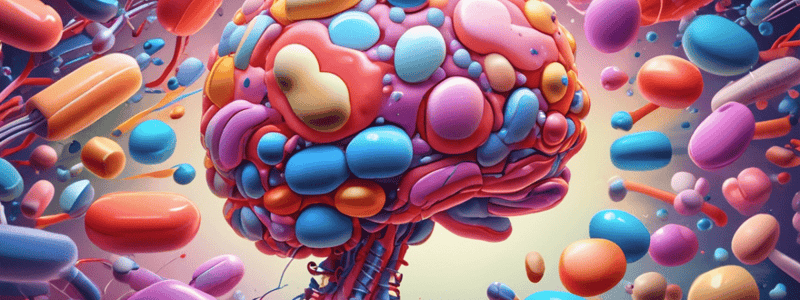Podcast
Questions and Answers
Which of the following is the most important reason for clinicians to understand the mechanism of action (MOA) of neurological medications?
Which of the following is the most important reason for clinicians to understand the mechanism of action (MOA) of neurological medications?
- To classify the medications into specific drug classes
- To minimize the risk of adverse effects
- To avoid potential drug interactions
- To determine the appropriate dosage for patients (correct)
Which of the following drug interactions is the most concerning when prescribing neurological medications?
Which of the following drug interactions is the most concerning when prescribing neurological medications?
- Additive sedative effects
- Competitive antagonism
- Enhanced metabolism
- All of the above are equally concerning (correct)
A patient is currently taking a monoamine oxidase inhibitor (MAOI) and the clinician wants to prescribe a selective serotonin reuptake inhibitor (SSRI). Which of the following is the most appropriate action?
A patient is currently taking a monoamine oxidase inhibitor (MAOI) and the clinician wants to prescribe a selective serotonin reuptake inhibitor (SSRI). Which of the following is the most appropriate action?
- Proceed with the SSRI prescription, as there is no risk of drug interaction
- Increase the dosage of the MAOI to counteract the effects of the SSRI
- Advise the patient to discontinue the MAOI before starting the SSRI
- Recommend an alternative medication that does not interact with the MAOI (correct)
Which of the following drug classes is primarily used to treat Parkinson's disease?
Which of the following drug classes is primarily used to treat Parkinson's disease?
A patient is currently taking a benzodiazepine medication for anxiety. Which of the following drug interactions is the clinician most likely to be concerned about when prescribing an opioid analgesic for the patient?
A patient is currently taking a benzodiazepine medication for anxiety. Which of the following drug interactions is the clinician most likely to be concerned about when prescribing an opioid analgesic for the patient?
Which factor is crucial for physicians to monitor and manage patient care effectively?
Which factor is crucial for physicians to monitor and manage patient care effectively?
What are some common side effects associated with neurological medications?
What are some common side effects associated with neurological medications?
Which aspect can vary widely depending on the specific medication and its intended use?
Which aspect can vary widely depending on the specific medication and its intended use?
What is one of the key considerations when weighing the risks and benefits of neurological medications for individual patients?
What is one of the key considerations when weighing the risks and benefits of neurological medications for individual patients?
Which type of antipsychotic medication is particularly useful in the treatment of positive symptoms associated with schizophrenia?
Which type of antipsychotic medication is particularly useful in the treatment of positive symptoms associated with schizophrenia?
For which condition can low doses of high-potency first-generation antipsychotics like haloperidol be used to treat agitation?
For which condition can low doses of high-potency first-generation antipsychotics like haloperidol be used to treat agitation?
What is a key difference in the mechanism of action between first- and second-generation antipsychotics?
What is a key difference in the mechanism of action between first- and second-generation antipsychotics?
Which symptomatology is specifically targeted by second-generation antipsychotics due to their serotonin receptor antagonism?
Which symptomatology is specifically targeted by second-generation antipsychotics due to their serotonin receptor antagonism?
What is one of the common therapeutic applications of antipsychotics in the context of acquired Immunodeficiency Syndrome-related dementia?
What is one of the common therapeutic applications of antipsychotics in the context of acquired Immunodeficiency Syndrome-related dementia?
Which of the following is a key therapeutic use of clozapine, a second-generation antipsychotic medication?
Which of the following is a key therapeutic use of clozapine, a second-generation antipsychotic medication?
Which side effect is the clinician most likely to monitor when prescribing second-generation antipsychotics for adolescent depression?
Which side effect is the clinician most likely to monitor when prescribing second-generation antipsychotics for adolescent depression?
Which of the following is a key therapeutic use of first-generation antipsychotics for patients with suicidal ideation?
Which of the following is a key therapeutic use of first-generation antipsychotics for patients with suicidal ideation?
Which of the following is a key mechanism of action for second-generation antipsychotics?
Which of the following is a key mechanism of action for second-generation antipsychotics?
Which movement disorder is a common side effect associated with long-term use of first-generation antipsychotic medications?
Which movement disorder is a common side effect associated with long-term use of first-generation antipsychotic medications?
Flashcards
Side Effects
Side Effects
Unintended consequences experienced by patients taking medication. They can range from mild to severe and affect various body systems.
Drowsiness
Drowsiness
A side effect characterized by excessive sleepiness and reduced alertness.
Dizziness
Dizziness
A side effect characterized by a feeling of lightheadedness, unsteadiness, or loss of balance.
Headaches
Headaches
Signup and view all the flashcards
Gastrointestinal Issues
Gastrointestinal Issues
Signup and view all the flashcards
Mechanism of Action (MOA)
Mechanism of Action (MOA)
Signup and view all the flashcards
Neurotransmitter Enhancement
Neurotransmitter Enhancement
Signup and view all the flashcards
Enzyme Inhibition
Enzyme Inhibition
Signup and view all the flashcards
Receptor Binding
Receptor Binding
Signup and view all the flashcards
Drug Interactions
Drug Interactions
Signup and view all the flashcards
Additive Sedative Effect
Additive Sedative Effect
Signup and view all the flashcards
Competitive Antagonism
Competitive Antagonism
Signup and view all the flashcards
Enhanced Metabolism
Enhanced Metabolism
Signup and view all the flashcards
Drug Classifications
Drug Classifications
Signup and view all the flashcards
Antiepileptic Drugs
Antiepileptic Drugs
Signup and view all the flashcards
Dopaminergic Agents
Dopaminergic Agents
Signup and view all the flashcards
Cholinesterase Inhibitors
Cholinesterase Inhibitors
Signup and view all the flashcards
Corticosteroids
Corticosteroids
Signup and view all the flashcards
Study Notes
Neurology Medications Pharmacology Exam: Focusing on Side Effects, Mechanism of Action, Drug Interactions, and Drug Classifications
Introduction
The field of neurology is vast and complex, requiring a deep understanding of pharmacology to effectively treat neurological conditions. This article provides an overview of key concepts relevant to a pharmacology exam for neurology medications, including side effects, mechanism of action, drug interactions, and drug classifications.
Side Effects
Side effects are unintended consequences experienced by patients taking medication. Understanding potential side effects is crucial for physicians to monitor and manage patient care, ensuring optimal outcomes. Some common side effects of neurological medications include drowsiness, dizziness, headaches, and gastrointestinal issues such as nausea and vomiting. It is essential to understand the potential risks and benefits of each medication, carefully weighing them against the specific needs of individual patients.
Mechanism of Action
Understanding the mechanism of action (MOA) of neurological medications is vital for predicting their effects and potential drawbacks. MOAs can vary widely depending on the specific medication and its intended use. For example, some medications work by enhancing neurotransmitter activity, while others inhibit certain enzymes or receptors. Knowledge of MOAs helps clinicians optimize dosages and monitor patient responses while minimizing potential adverse effects.
Drug Interactions
Drug interactions occur when two or more medications react negatively with one another, potentially increasing the likelihood of side effects or decreasing the effectiveness of one or both medications. Identifying and managing drug interactions is critical for safe and effective patient care. Common types of drug interactions affecting neurological medications include additive sedative effects (e.g., combining benzodiazepines with opioids), competitive antagonism (e.g., using antipsychotics with anticholinergic agents), and enhanced metabolism (e.g., administering selective serotonin reuptake inhibitors with monoamine oxidase inhibitors).
Drug Classifications
Classifying neurological medications into specific categories helps clinicians understand their therapeutic potential and potential side effects. Common drug classes relevant to neurology include antiepileptic drugs (e.g., valproate, phenobarbital), dopaminergic agents (e.g., levodopa, bromocriptine), cholinesterase inhibitors (e.g., donepezil, rivastigmine), and corticosteroids (e.g., prednisone, dexamethasone). Understanding the properties and indications of different classes enables clinicians to make informed decisions regarding treatment selection and optimization.
In conclusion, mastering the subtopics of side effects, mechanism of action, drug interactions, and drug classifications is essential for anyone preparing for a pharmacology exam on neurology medications. By staying well-versed in these areas, healthcare professionals can ensure the best possible outcomes for patients dealing with neurological disorders.
Studying That Suits You
Use AI to generate personalized quizzes and flashcards to suit your learning preferences.




